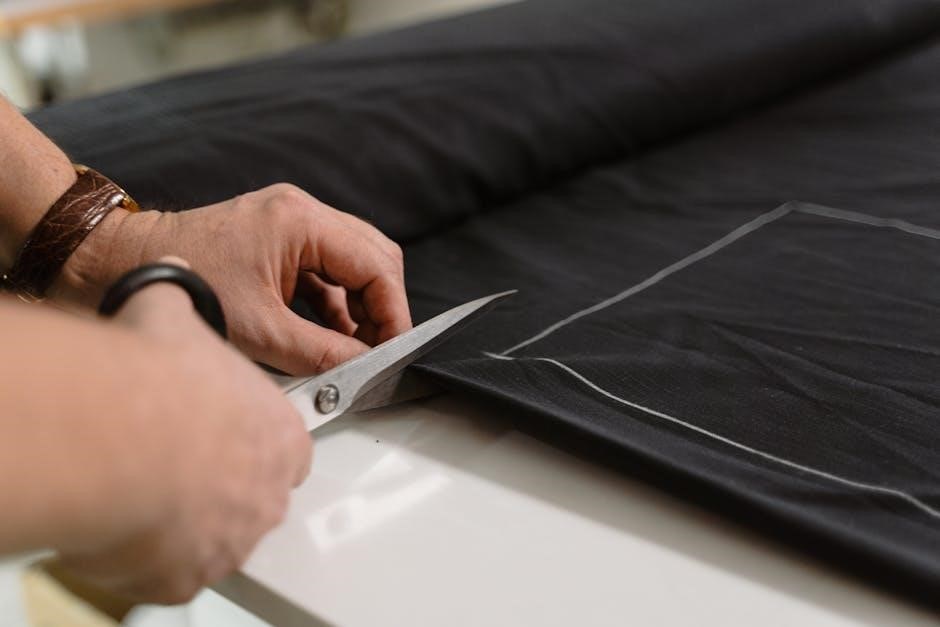A well-fitting dress shirt is essential for a polished look․ This guide helps you understand measurements, from neck to sleeve length, ensuring a perfect fit every time․
Understanding Men’s Dress Shirt Measurements
Accurate measurements are crucial for a perfect fit․ Key areas include neck, chest, waist, sleeve length, and shirt length, ensuring comfort and a tailored appearance․
2․1․ Importance of Accurate Measurements
Accurate measurements are essential for a dress shirt that fits perfectly․ Ill-fitting shirts can lead to discomfort, restricted movement, or an unpolished appearance․ Proper measurements ensure the shirt sits comfortably around the neck, chest, and waist while allowing ease of motion․ Inaccurate measurements can result in a shirt that is too tight, causing discomfort, or too loose, compromising style․ By understanding and accurately measuring key areas, you can avoid common fit issues and achieve a tailored look․ This guide will walk you through the process step-by-step, ensuring your measurements are precise and your dress shirt fits flawlessly․
2․2․ Key Measurement Points: Neck, Chest, Waist, Sleeve, and Shirt Length
Accurate measurements for a dress shirt focus on five key areas: neck, chest, waist, sleeve length, and shirt length․ The neck measurement determines the collar size, ensuring comfort and a proper fit․ The chest measurement is taken at the widest point to ensure the shirt isn’t too tight or loose․ Waist measurements help tailor the shirt for a flattering silhouette․ Sleeve length is measured from the shoulder to cuff, ensuring the cuffs hit the wrist correctly․ Shirt length is measured from the base of the collar to the desired hemline, ensuring the shirt stays tucked in comfortably․ These measurements ensure a tailored fit․
How to Measure Yourself Accurately
Use a flexible tape measure and stand upright․ Keep the tape snug but not tight․ Measure in front of a mirror for accuracy and consistency․
3․1․ Measuring the Neck
To measure your neck, place the tape around the base where the collar sits․ Keep it snug but not tight, allowing room for one finger․ Ensure the tape is level and parallel to the floor․ This measurement determines your collar size, a crucial factor in achieving comfort and a proper fit․ Round up to the nearest half-inch for accuracy․ Avoid pulling the tape too tightly, as this can lead to a restrictive fit․ A correct neck measurement ensures your dress shirt sits comfortably and looks sharp․ This step is foundational for all other measurements․
3․2․ Measuring the Chest
Measure your chest by wrapping the tape around the widest part, ensuring it’s level and parallel to the floor․ Keep the tape snug but not tight, and avoid pulling it too taut․ This measurement helps determine the shirt’s fit around your torso․ Double the chest measurement to get the full circumference, which is often used in size charts․ For accuracy, measure over a thin layer of clothing, like a t-shirt, to ensure the fit isn’t too restrictive or loose․ This step is vital for a comfortable and flattering fit, ensuring the shirt drapes well across your body without feeling overly tight or baggy․
3․3․ Measuring the Waist
To measure your waist, wrap the tape around the narrowest part of your torso, typically just above your hips․ Ensure the tape is level and parallel to the floor․ Keep it snug but not overly tight, allowing for a full range of motion․ This measurement is crucial for determining the shirt’s fit around your midsection, particularly for styles with darts or tailored waists․ Stand upright and relax while measuring to ensure accuracy․ For the best fit, measure over a thin layer of clothing, like an undershirt, to avoid a restrictive feel․ This step helps achieve a balanced silhouette, preventing the shirt from being too tight or overly loose․
3․4․ Measuring Sleeve Length
To measure sleeve length, start by placing the tape at the center back of your neck, just below the base where the collar sits․ Gently guide the tape over your shoulder, following its natural curve, and extend it down to your wrist․ The tape should hang loosely, allowing for a slight bend in the elbow․ This ensures the shirt sleeves will be long enough to cover your arms comfortably without being overly long․ Stand straight and relax while measuring to get an accurate reading․ Proper sleeve length ensures the cuffs will sit correctly on your wrists, completing the shirt’s fit․
3․5․ Measuring Shirt Length
Measuring shirt length involves determining how long the shirt should be to fit your torso properly․ Start by placing the measuring tape at the base of your neck, just below the collar, and extend it straight down the center of your back․ The tape should hang naturally without pulling tight․ Stand up straight and relax to ensure an accurate measurement․ For a standard fit, the length typically ranges from 32 to 34 inches for slim-fit shirts and up to 36 inches for classic or relaxed fits․ Longer lengths may be preferred for taller individuals or formal styles․ This measurement ensures the shirt will sit comfortably below the waistline, providing a balanced look․

Men’s Dress Shirt Size Charts
Standard size charts categorize shirts by chest and neck measurements, ensuring a tailored fit; Sizes range from Small to Extra-Large, with precise metrics to match your body dimensions․
4․1․ Standard Size Charts
Standard size charts for men’s dress shirts typically categorize fits based on chest and neck measurements․ These charts provide a universal guide, ensuring consistency across brands․ They often include measurements in both inches and centimeters, making it easier for individuals worldwide to determine their size․ For example, a Small size might correspond to a chest measurement of 34-36 inches (86-91 cm) and a neck size of 14-14․5 inches (35․5-36․8 cm)․ Medium, Large, and Extra-Large sizes follow similar patterns, with incremental increases in both chest and neck measurements․ This system helps consumers find a shirt that fits comfortably without the need for custom tailoring․
4․2․ Slim Fit vs․ Classic Fit
Slim fit and classic fit shirts differ significantly in cut and style․ Slim fit shirts are tailored closer to the body, with narrower sleeves and a shorter length, creating a modern, streamlined appearance․ They are ideal for those who prefer a contemporary look and have a slimmer build․ Classic fit shirts, on the other hand, offer a looser, more traditional cut, providing comfort and flexibility for various body types․ The classic fit is often preferred by those who value ease of movement or have a broader chest and shoulders․ Understanding these differences helps in selecting the most flattering style for your body type․

How to Choose the Right Fit
Choosing the right fit involves understanding your body type and personal style․ Consider whether you prefer a slim, classic, or relaxed fit․ Use your measurements and existing shirts as guides to ensure comfort and confidence․ This section will help you make an informed decision․
5․1․ Determining Your Body Type
Understanding your body type is crucial for selecting the right fit․ Common categories include slim, medium, athletic, and larger builds․ Slim body types look best in tailored fits, while athletic builds may require more room in the chest and shoulders․ Measure your chest, waist, and shoulders to identify your shape․ If your chest and shoulders are proportionally broad, opt for a relaxed fit․ For a balanced silhouette, consider classic or slim styles․ Your body type will guide you in choosing between slim, classic, or relaxed fits, ensuring comfort and a flattering appearance․ This step is key to making informed style decisions․
5․2․ Understanding Fit Styles
Men’s dress shirts come in various fit styles to cater to different preferences and body types․ Slim-fit shirts are tailored closely to the body, offering a modern, streamlined look․ Classic-fit shirts provide a traditional, slightly looser cut for comfort and versatility․ Relaxed-fit shirts are the loosest, ideal for casual settings or larger builds․ Each style affects how the shirt drapes on the body․ Slim fits accentuate a lean physique, while classic fits suit most body types․ Relaxed fits offer maximum comfort but may lack a polished appearance․ Choosing the right fit style depends on your lifestyle, personal preference, and the occasion․
Common Mistakes to Avoid
When measuring for a dress shirt, common mistakes include using an inflexible tape measure, pulling the tape too tight or too loose, and not accounting for posture․ Many people forget to measure at the widest part of the chest or base of the neck․ Others neglect to consider sleeve length properly, leading to shirts that are too short or too long․ Additionally, not measuring over clothing or failing to round up to the nearest size can result in an ill-fitting shirt․ Avoiding these errors ensures accurate measurements and a better fit․ Proper technique and attention to detail are essential for success․

Using an Existing Shirt as a Guide
Using a well-fitting dress shirt as a guide is a practical way to determine your measurements․ Lay the shirt flat and measure across the chest, from one seam to the other, to find the chest width․ Double this measurement for the full circumference․ For sleeve length, measure from the center back of the neck to the cuff․ Ensure the collar fits comfortably by comparing its size to your neck measurement․ This method avoids the need for self-measurement and provides a reliable reference for sizing․ It’s especially useful when shopping online or for custom tailoring, ensuring consistency and accuracy in fit․

Custom Tailoring Options
Custom tailoring offers a personalized approach to dress shirts, ensuring a flawless fit tailored to your measurements․ By providing precise neck, chest, sleeve, and shirt length measurements, you can create a shirt that aligns perfectly with your body․ Customize styles, such as collar types, cuff preferences, and fabric choices, to suit your taste․ Many tailors also allow you to provide a well-fitting shirt as a reference for replication․ This option is ideal for those who find standard sizes inadequate or desire unique detailing․ The process typically involves a consultation to discuss preferences and ensure every aspect meets your expectations for the perfect fit․
Caring for Your Dress Shirt
Wash inside out in cold water, avoid machine drying, and iron while slightly damp to maintain quality and extend lifespan․
9․1․ Washing and Ironing Tips
For optimal care, wash your dress shirt inside out in cold water to protect the fabric and prevent color fading․ Avoid using harsh detergents or bleach․ Gently tumble dry on low heat or air-dry to maintain shape․ Iron while the shirt is slightly damp, starting with the collar, then the yoke, and finally the sleeves and front․ Use a medium heat setting and avoid ironing over buttons or labels․ Regular steaming can also help maintain the shirt’s crisp appearance without damaging the fabric․ Proper care ensures longevity and keeps your dress shirt looking its best․
Troubleshooting Fit Issues
If your dress shirt feels too tight in the collar, check if the neck measurement aligns with your actual size․ A restrictive sleeve length may indicate a need for a longer sleeve measurement․ If the shirt is too long or short, compare the shirt length measurement to your torso length․ A gaping chest area could mean the chest measurement is too large, while a tight chest suggests the measurement is too small․ Adjusting these measurements or consulting a tailor can resolve most fit issues, ensuring comfort and a tailored appearance․
Accurate measurements are key to a perfect fit․ Understanding your size ensures comfort and style․ Use this guide to make informed choices and enjoy your tailored look confidently․
11․1; Key Takeaways
Measure accurately around the neck, chest, waist, and sleeves for the best fit․ Use size charts to guide your selection and consider your body type when choosing styles․ Regular care ensures longevity․ Troubleshoot fit issues by adjusting measurements or seeking custom options․ Always reference a well-fitting shirt for consistency․ Remember, proper measurements lead to confidence and comfort in your dress shirt choice․
